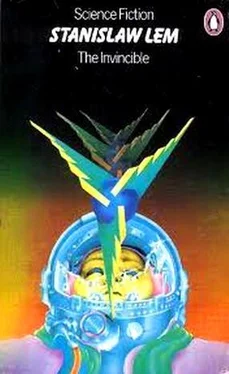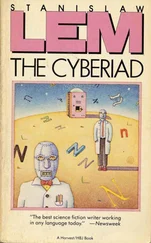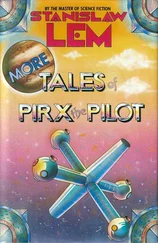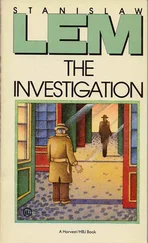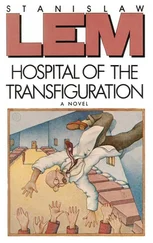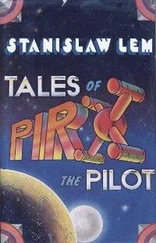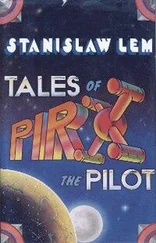It’s a city, thought Rohan with excitement. The room was silent as the technician tried in vain to get the picture into a sharper focus.
“Were there any disturbances during transmission?” the astrogator’s calm voice broke through.
“No,” replied Ballmin out of the dark. “We had good transmission, but this shot was one of the last of the third group of satellites. Eight minutes after it had been launched, it no longer reacted to our signals. This photo was probably taken after the objectives had already been damanged by the rapidly rising temperature.”
“The camera was at a distance of roughly forty miles from the center of this structure,” interjected another voice, that Rohan recognized. It was Malte, one of the most talented planetologists.
“I’d be inclined to put the distance rather at some thirty to thirty-five miles. Will you look at this, please?” The astrogator’s body obscured part of the screen. He took a transparent stencil with many circles and placed it over the various craters in the visible part of the screen.
“These are definitely larger than those of the earlier shots. But it doesn’t matter, either way you look at it…” he added without completing his sentence.
They all knew what he had meant to say: soon they would be able to judge for themselves whether the satellite cameras had been properly focused. For a few moments they regarded the image on the screen. Rohan was no longer certain whether this was a city or the ruins of one. That these geometrically regular structures must have been abandoned for quite some time could be concluded from the pencil-thin wavy shadows of the dunes which encircled them. Some of these constructions had been almost totally covered by the sand. The geometrical order of the ruins was divided into two uneven parts by a zigzag line which grew wider as it stretched further inland. This tectonic fissure cut several of the large “buildings” in half. One of these had toppled over and formed a bridge across the chasm.
“Lights, please,” sounded the astrogator’s voice. As bright lamps illuminated the cabin he glanced over to the clock on the wall. “We’ll leave in two hours.”
Dissatisfied comments greeted this announcement. The loudest protests came from the assistants to the chief geologist; they had already drilled 200 yards down into the ground to obtain soil and rock specimens. With a slight wave of his hand Horpach indicated that he wished no further discussion. “All machines are to return on board ship. Make safe any material obtained so far. Continue examining the photos and carry on with all necessary analyses. Where is Rohan? Oh, there you are. Did you hear what I said? Everyone to be ready for takeoff in two hours!”
The men loaded the machines into the Invincible’s hold. They worked fast but with systematic precision. Rohan turned a deaf ear to Ballmin’s pleas for just fifteen minutes more to finish drilling for his last core sample.
“You have all heard the commander’s orders; now get a move on,” he shouted, urging the men to greater speed as they drove their big cranes toward the ditches and drilling holes. Drilling equipment, provisional turnstiles and fuel drums disappeared quickly in the open hatches leading to the ship’s storerooms. Soon the upturned ground was the only sign left of all their activities. Then Rohan and Westergarde, the substitute chief engineer, made one final inspection of the now deserted working places outside the spacecraft. After having taken care of this last precautionary measure, the two men quickly embarked.
A great commotion then sprang up in the sandy dunes around the ship, caused by the energo-robots obeying the radio signal to return to their craft. Quickly waddling along in single file they soon reached their home base.
Now the ramp and the vertical elevator shaft were pulled inside. For another instant nothing moved: the lull before a storm.
Then the metallic whistling of the air sounded its noisy protest as it was squeezed through the jets. A storm broke loose. Around the nose of the Invincible greenish dust clouds performed a mad dance. Their pale glow seemed to ooze out until it blended with the red light of the sun.
Deafening thunder shook the desert around the ship. Admidst the echoes reverberating from the nearby rock walls the spaceship ascended slowly but with growing speed and soon disappeared in the violet skies above. All that remained of the landing area was a circle burnt into the rocky ground, glazed-over dunes and vapor trails high up in the sky.
When the last trace of the rocket’s presence, a whitish haze, had been absorbed by the atmosphere, when the wandering sandy waves gradually began to cover up the naked rock of the ground, at the same time filling in the deserted digging spaces — only then, much later, did a dark cloud gather in the west. Hovering low above the earth it pushed close, grew, encircled the landing area with a threatening arm. There it remained, motionless.
As the sun was about to set, a black rain fell on the desert.
The Invincible landed at a carefully selected spot almost four miles from the northern periphery of the “city,” which could be clearly seen from inside the control center. The impression of dealing here with some artificial constructions became even stronger now than before, when the men had carefully scanned the photos made by the satellites. The structures were angular, usually broader at the bottom than at the upper end. They came in various sizes and stretched over many miles, sometimes with a metallic sheen, sometimes simply black. But even the strongest field glasses would not reveal any details. Most of the buildings seemed to be perforated like a sieve.
This time the tinny clanking of the cooling jets had scarcely died down when the Invincible put out the ramp and the elevator shaft, and surrounded itself with the protective chain of energo-robots. But there were some additional precautionary measures. Exactly opposite the “city,” which could not be seen from the ground as it lay hidden by some low hills, a convoy was formed. An energy dome arched over the convoy that consisted of five cross-country jeeps and a mobile antimatter mortar. It was about twice the size of the vehicles and resembled an apocalyptic bug with bluish glittering wing cases.
Rohan was the commander of this operational troop. He stood upright in the turret hatch of the first vehicle awaiting the signal that would allow them free passage through the force field. Two info-robots had been positioned on nearby hillocks; there they began shooting off a series of long-burning green flares. This clearly marked the path; the small column started to roll. Rohan’s car was at the head of the troop.
The engines hummed with their deep bass voices; the heavy balloon tires spewed up fountains of sand. Two hundred yards ahead flew a scouter robot, skimming close to the ground. The robot looked like a flat saucer with rapidly vibrating antennae. These vibrations created an air current which shot hissing into the ridges of the dunes. One could almost believe the flying robot had set the dunes aflame with an invisible fire. The swirling dust cloud lingered in the still air, marking with a puffy reddish line the direction taken by the expedition.
The shadows of the machines grew longer; it was shortly before sunset. The column was forced to make a detour around a small crater that was almost filled with sand. Twenty minutes later the troop reached the edge of the ruins.
They broke formation. Three unmanned vehicles left the train and placed blue lights as a sign that a localized force field had been erected. The two manned cars rolled forward under the protection of the mobile energy dome. Fifty yards behind them the giant antimatter mortar followed, stalking along on its curved telescopic legs.
Читать дальше
